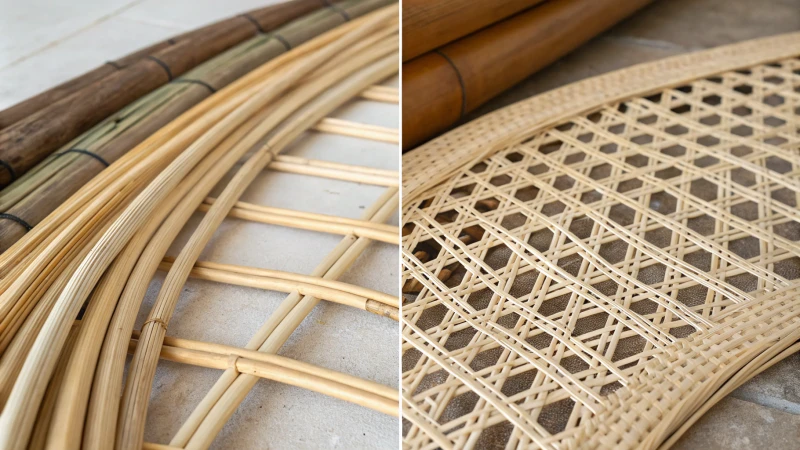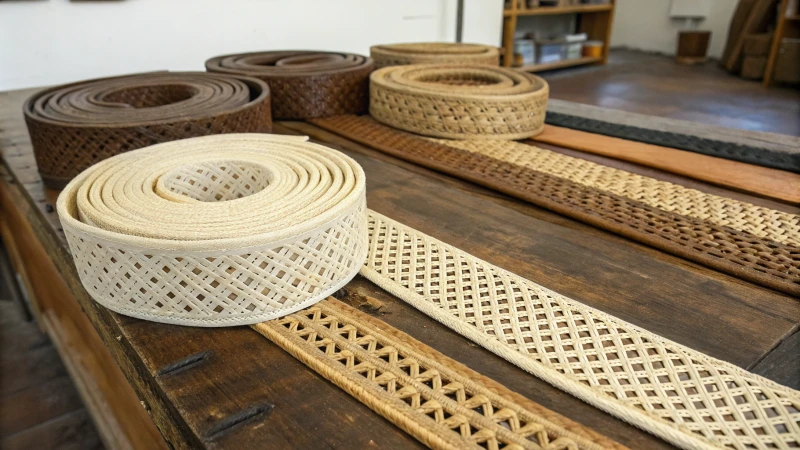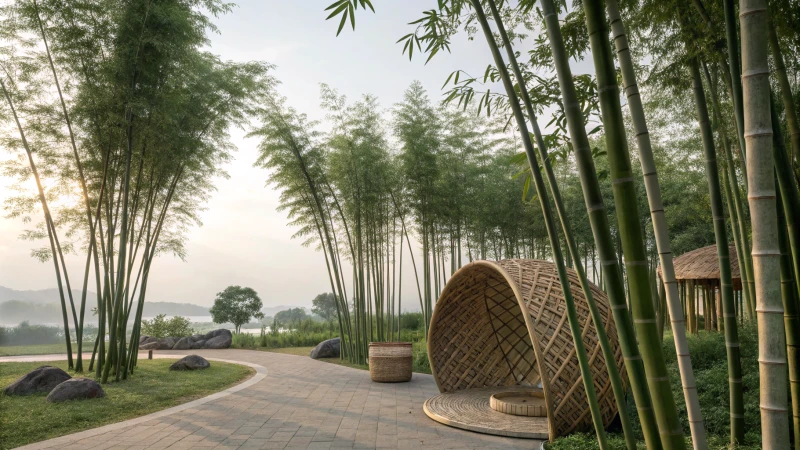
Do rattan and cane webbing confuse you? I totally understand! In my early days in furniture design, I got lost in a maze of words and materials. Let’s simplify it together!
Rattan webbing comes from the stems of rattan palms. Stems are known for their durability and flexibility. On the other hand, cane webbing refers to the outer skin of rattan. This outer skin is often used for decoration. Recognizing these differences probably helps you choose wisely in furniture design and buying.
I remember the first time I had to choose between rattan and cane webbing for a project. The vibrant designs and textures looked mesmerizing. I quickly realized that understanding the materials was very important. Rattan webbing comes from the strong stems of rattan palms. It offers great durability and flexibility. Cane webbing, however, comes from the outer skin of rattan. People use it often for its decorative charm. Knowing these differences really helps with your furniture design choices. It helps you select the best fit for your project. Choosing the right material is crucial.
Rattan webbing is more durable than cane webbing.True
Rattan webbing, made from stems, is known for its durability compared to cane webbing, which is made from the outer skin.
Cane webbing is primarily used for structural support.False
Cane webbing is mainly decorative and not typically used for structural support like rattan webbing.
What Makes Rattan Webbing So Unique?
Do you often think about why rattan webbing is now popular in furniture design? It is not only about appearance. There is really much more underneath!
Rattan webbing is known for its flexibility, strength, beauty, eco-friendliness and easy care. These features suit it perfectly for different furniture uses. It is very durable and visually attractive.

Flexibility and Strength
Rattan webbing truly speaks to me. When I first saw it in a workshop, its special mix of features amazed me. It’s not just about how it looks; every piece seems to carry its own story and feelings.
Rattan webbing bends beautifully. I watched a craftsman shape it into a chair, turning it into art. It bends without breaking, which makes it ideal for curved furniture like chairs and room dividers. The tensile strength of rattan also provides durability, ensuring that the webbing can withstand significant weight without compromising its integrity.
This combination of flexibility and strength sets rattan apart from other materials like bamboo or cane, which may lack the same resilience in similar applications. For more insights on rattan’s strength, check out strength comparisons1.
Aesthetic Appeal
Rattan webbing is beautiful. Its warm tones and natural textures fit any space, from modern apartments to cozy cottages. Variety is another great aspect. Rattan comes in many patterns and colors, allowing customization for personal tastes. Each piece tells a story, either through fine weaving or bright colors. I chose a vibrant design recently and it brought joy to the entire room.
Designers often choose rattan for its ability to complement various styles, from contemporary to traditional. Additionally, the webbing can be finished in a variety of patterns and colors, allowing for customization that meets specific design requirements. For ideas on rattan patterns, explore design options2.
Sustainability
Sustainability is important to me and finding out rattan is eco-friendly was a big deal. It’s harvested from fast-growing plants that need few resources. This makes it great for eco-conscious people like me. When sourced from responsible suppliers, rattan webbing can come with certifications such as FSC (Forest Stewardship Council), ensuring that it meets ethical and environmental standards.
Choosing rattan feels good because it supports sustainable practices and creates beautiful furniture. Exploring the sustainability of rattan versus other materials can provide further insights into its benefits. Check out sustainable materials3.
Easy Maintenance
Rattan webbing is easy to care for! After a busy dinner party, I often just wipe surfaces with a damp cloth, happy my rattan pieces still look elegant in busy areas. Unlike synthetic options, rattan keeps its charm with little effort.
For maintenance tips and care instructions, visit care guide4. To keep rattan looking its best, I refer to care guides for useful tips and tricks!
Rattan webbing is more flexible than bamboo webbing.True
Rattan webbing's superior flexibility allows it to bend without breaking, unlike bamboo, making it ideal for curved furniture designs.
Rattan webbing requires extensive maintenance.False
Contrary to many materials, rattan webbing is low maintenance and can be cleaned easily with a damp cloth, making it user-friendly.
What Makes Cane Webbing Unique in Texture and Appearance?
Have you ever touched cane webbing and felt the unique textures? Each variation shares a story. Choosing the right texture probably changes your furniture into a masterpiece. Let’s explore these interesting differences together!
Cane webbing shows unique texture and look. It offers smooth, textured and rustic finishes. These differences impact how attractive it is. They also decide which furniture styles suit it best. The variety in finishes makes it adaptable.

Understanding Cane Webbing Textures
Cane webbing comes in various textures that can greatly influence the overall aesthetic of furniture. Typically, these textures can be classified into three main types: smooth, textured, and rustic. Each type serves a different purpose and can evoke distinct feelings when integrated into furniture design.
-
Smooth Cane Webbing:
Smooth cane webbing looks very elegant with its shiny surface. I used smooth cane in a chair design and got endless compliments! It’s easy to clean and gives a bright, polished look. This look is perfect for busy areas. -
Textured Cane Webbing:
Textured cane webbing has intricate patterns. It adds depth and can change a room’s entire atmosphere. I used it in a bohemian-style chair and it became the room’s centerpiece. It sparked many conversations. Textured cane stands out. It’s ideal for those wanting to make a bold statement! -
Rustic Cane Webbing:
Rustic cane feels warm and inviting. Its natural flaws and uneven surfaces remind me of cozy evenings at a friend’s farmhouse. It’s perfect for creating a welcoming organic vibe in homes.
Choosing the right texture really changes your design style. If you’re curious about texture’s impact on style, explore our resources on material selection5.
The Appearance of Cane Webbing
The appearance of cane webbing varies based on the processing methods and materials used in its production. Here are some aspects to consider:
| Type | Appearance Description | Common Uses |
|---|---|---|
| Natural Cane | Light golden color with a smooth finish | Chairs, Cabinets |
| Stained Cane | Darker hues enhancing grain visibility | Accent pieces, Decor |
| Dyed Cane | Vivid colors for artistic expression | Modern furniture, Art |
Color Variations in Cane Webbing
Different staining techniques can significantly alter the appearance of cane webbing. Natural cane tends to have a subtle, warm hue that complements various interior styles. Stained and dyed options offer versatility, allowing designers to match specific color schemes in their projects. For example, darker stains can create a more sophisticated look, while vibrant dyes can make bold statements in contemporary designs. Explore more about color applications in cane webbing by visiting our guide on color theory in design6.
The Role of Finish in Texture and Appearance
Finishing treatments applied to cane webbing also affect its texture and appearance. Here are some finishes that are commonly used:
-
Matte Finish:
Matte provides a soft look, great for rustic designs. -
Gloss Finish:
Gloss adds shine and vibrancy, ideal for modern styles. -
Oil Finish:
Oil finish not only protects but also deepens the natural color of cane.
Each finish changes how light plays on the surface; it alters texture perception and adds character. For more insights, check our article on finishing techniques7.
Understanding these differences will aid you in choosing the right cane webbing for your furniture or decor projects. By considering texture and appearance, you can ensure your selections align with both your design vision and functional requirements.
Cane webbing comes in three main textures: smooth, textured, rustic.True
Cane webbing is classified into three primary textures, each offering unique aesthetic qualities for furniture design.
Natural cane webbing is typically dark in color and glossy.False
Natural cane webbing usually has a light golden color with a smooth finish, not dark or glossy.
How Do Rattan and Cane Webbing Transform Furniture Design?
Have you ever thought about how rattan and cane webbing can improve your furniture style? Their interesting uses create a special appeal in home decor. These materials offer a sustainable charm. People really love them in their homes.
Rattan and cane webbing are popular in furniture. These materials are useful for seating, cabinetry and decoration. Their unique textures improve how things look. They also offer durability and comfort. Rattan and cane webbing fit perfectly in eco-friendly designs. They are ideal for sustainable creations.

1. Rattan Webbing in Seating
Rattan webbing is widely used in chairs, sofas, and benches due to its durability and aesthetic appeal.
I felt amazed the first time I used rattan webbing in seating designs. My chairs and sofas became very special. They looked timeless and strong. I remember sitting on a woven rattan chair; it felt like being gently held. Rattan supports weight well and matches modern styles. Moreover, its breathable nature makes it ideal for outdoor furniture as well. Many sunny days were spent outside with friends in these seats.
2. Cabinet Doors and Room Dividers
In cabinetry, rattan webbing is often incorporated into doors to create a light and airy feel.
I picked rattan webbing for a bohemian room’s cabinet doors; the outcome was stunning as the natural texture blended nicely with different styles. Room dividers made with cane webbing serve not only functional purposes but also act as stunning visual elements in open spaces, really catching the eye.
3. Accents and Decorative Features
Rattan and cane webbing can be utilized as accent pieces, enhancing furniture with unique textures.
I’ve used them in table lamps and picture frames; each one added warmth and charm to my home. This versatility allows designers to play with shapes and finishes that suit modern tastes, bringing any room to life.
4. Eco-Friendly Furniture Solutions
Incorporating rattan and cane webbing aligns with sustainability goals in furniture manufacturing.
Working with these materials supports sustainability as they are often sourced from renewable resources, matching my eco-friendly values while attracting environmentally aware customers who share my love for sustainable living.
Summary Table of Uses
| Furniture Type | Use of Rattan/Cane Webbing | Benefits |
|---|---|---|
| Seating | Chairs, sofas, benches | Comfort & durability |
| Cabinetry | Doors, panels for cabinets | Aesthetic appeal |
| Decorative Accents | Lamps, frames, and accessories | Unique texture & warmth |
| Eco-Friendly Options | Sustainable furniture solutions | Appeals to eco-conscious buyers |
Rattan webbing enhances seating comfort in furniture.True
Rattan webbing provides a sturdy yet flexible seat, improving comfort in chairs, sofas, and benches.
Cane webbing is not eco-friendly for furniture manufacturing.False
Cane webbing is often sourced from renewable resources, making it an eco-friendly option for sustainable furniture.
Which Material Is More Eco-Friendly and Sustainable?
While I travel through the world of sustainable materials, I often wonder, which materials really matter? Let’s explore this curiosity together!
To determine which material is more eco-friendly and sustainable, think about renewability, production impact and lifecycle effects. Bamboo and rattan grow very quickly. Both materials decompose naturally. These qualities make them very eco-friendly.

Understanding Eco-Friendly Materials
When exploring the world of eco-friendly materials, it’s crucial to understand what makes a material sustainable. Generally, materials can be categorized based on their renewable sources, production processes, and lifecycle impacts.
For example, bamboo is often celebrated for its rapid growth and minimal resource needs. In contrast, traditional hardwoods may require decades to mature, making them less sustainable overall.
To gain deeper insights, check out this guide8 on sustainable materials.
Comparing Common Materials
Here’s a quick comparison of some popular materials regarding their eco-friendliness:
| Material | Renewability | Production Impact | End-of-Life Impact |
|---|---|---|---|
| Bamboo | High | Low | Biodegradable |
| Rattan | Moderate | Moderate | Biodegradable |
| Cotton | High | High (water use) | Biodegradable |
| Polyester | Low | High | Non-biodegradable |
| Wood (FSC) | Moderate | Moderate | Biodegradable |
The Role of Certifications
Certifications play a significant role in determining the sustainability of materials. For instance, the FSC (Forest Stewardship Council)9 certification ensures that wood products come from responsibly managed forests. This can greatly impact procurement decisions, especially for professionals who prioritize environmental standards.
Additionally, looking for certifications such as GOTS (Global Organic Textile Standard) for textiles can guide you toward more sustainable choices.
The Importance of Lifecycle Assessment
A lifecycle assessment (LCA) evaluates the environmental impact of a product from cradle to grave. This includes raw material extraction, production, usage, and disposal. Understanding the LCA can help identify the most sustainable options available in the market. For a detailed analysis, explore this resource10 on lifecycle assessments.
Local vs. Global Sourcing
Another factor to consider is the sourcing location of materials. Local materials generally have a lower carbon footprint due to reduced transportation emissions. For instance, sourcing rattan locally can significantly decrease environmental impact compared to importing it from distant countries.
Engaging with local suppliers who follow sustainable practices is essential for achieving both quality and eco-friendliness. Consider checking local sourcing guidelines via this link11.
Trends in Sustainable Materials
As sustainability becomes more mainstream, various innovative materials are emerging. For example, mycelium (mushroom-based material) and recycled plastics are gaining traction for their eco-friendly attributes.
Staying updated on trends can help in making informed procurement choices that align with sustainability goals. Explore more about these trends here12.
Bamboo is more sustainable than traditional hardwoods.True
Bamboo grows rapidly and requires fewer resources, making it a more sustainable choice compared to hardwoods that take decades to mature.
Polyester is biodegradable and eco-friendly.False
Polyester is non-biodegradable and has a high environmental impact, making it less eco-friendly compared to natural materials.
Conclusion
Discover the differences between rattan and cane webbing, including durability, flexibility, aesthetic appeal, and eco-friendliness to make informed choices for furniture design.
-
Discover more about rattan’s distinct properties and how they can enhance your designs. ↩
-
Explore different patterns and finishes available for rattan webbing to elevate your furniture design. ↩
-
Learn about the sustainability benefits of using rattan as a material in your projects. ↩
-
Get tips on maintaining rattan webbing to ensure its longevity and appearance. ↩
-
This link provides valuable insights into selecting the right materials based on texture and appearance, crucial for making informed purchasing decisions. ↩
-
Explore this resource for a comprehensive understanding of color theory and its application in cane webbing design. ↩
-
Learn about various finishing techniques to enhance the durability and look of cane webbing, which is essential for any furniture project. ↩
-
Discover the benefits of using eco-friendly materials in your projects and how they contribute to sustainability. ↩
-
Learn about various sustainability certifications that can help you choose the right materials. ↩
-
Find out how lifecycle assessments can guide your choices towards more sustainable materials. ↩
-
Understand the advantages of sourcing materials locally and its impact on sustainability. ↩
-
Stay ahead of emerging trends in sustainable materials and their applications. ↩

